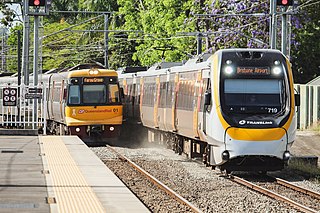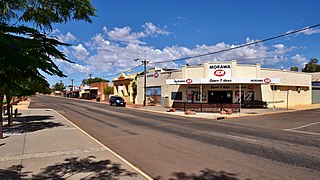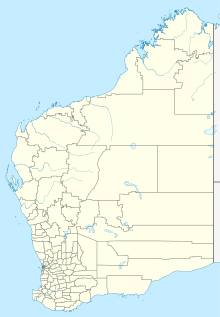
The Adelaide–Darwin railway line is a railway line in Australia, between the South Australian town of Tarcoola and the Northern Territory city of Darwin. Preceded by a number of other shorter railways, a line through to Darwin was fully realised in 2004 when the final link from Alice Springs to Darwin was opened. Forming the main section of the 2,975 kilometres (1,849 mi) rail corridor between the cities of Adelaide and Darwin, the line is used by The Ghan passenger train and interstate freight trains operated by Aurizon.

Rail transport in Australia is a component of the Australian transport system. It is to a large extent state-based, as each state largely has its own operations, with the interstate network being developed ever since Australia's federation in 1901. As of 2022, the Australian rail network consists of a total of 32,929 kilometres (20,461 mi) of track built to three major track gauges: 18,007 kilometres (11,189 mi) of standard gauge, 2,685 kilometres (1,668 mi) of broad gauge, and 11,914 kilometres (7,403 mi) of narrow gauge lines. Additionally, about 1,400 kilometres (870 mi) of 610 mm / 2 ft gauge lines support the sugar-cane industry. 3,488 kilometres (2,167 mi), around 11 per cent of the Australian heavy railways network route-kilometres are electrified.
Australians generally assumed in the 1850s that railways would be built by the private sector. Private companies built railways in the then colonies of Victoria, opened in 1854, and New South Wales, where the company was taken over by the government before completion in 1855, due to bankruptcy. South Australia's railways were government owned from the beginning, including a horse-drawn line opened in 1854 and a steam-powered line opened in 1856. In Victoria, the private railways were soon found not to be financially viable, and existing rail networks and their expansion were taken over by the colony. Government ownership also enabled railways to be built to promote development, even if not apparently viable in strictly financial terms. The railway systems spread from the colonial capitals, except for a few lines that hauled commodities to a rural port.

Morawa is a town in the Mid West region of Western Australia. It is located within the Shire of Morawa, approximately 370 kilometres (230 mi) north of the state capital Perth, on the railway line between Wongan Hills and Mullewa.

Vale S.A., formerly Companhia Vale do Rio Doce is a Brazilian multinational corporation engaged in metals and mining and one of the largest logistics operators in Brazil. Vale is the largest producer of iron ore and nickel in the world. It also produces manganese, ferroalloys, copper, bauxite, potash, kaolin, and cobalt, currently operating nine hydroelectricity plants, and a large network of railroads, ships, and ports used to transport its products.

Railways in Western Australia were developed in the 19th century both by the Government of Western Australia and a number of private companies. Today passenger rail services are controlled by the Public Transport Authority through Transperth, which operates public transport in Perth, and Transwa, which operates country passenger services. Journey Beyond operates the Indian Pacific.
Iron ore production in Africa is dominated by South Africa, Mauritania and Algeria. Many countries possess iron ore deposits that are as yet untapped/unmined. Countries and companies currently involved in production are listed here; measurements are in tonnes per annum(year).

Fortescue Metals Group Limited is an Australian iron ore company. As of 2017, Fortescue is the fourth-largest iron ore producer in the world. The company has holdings of more than 87,000 km2 in the Pilbara region of Western Australia, making it the largest tenement holder in the state, larger than both BHP and Rio Tinto.

Port Bonython is the location of a deepwater port, gas fractionation plant and diesel storage facility west of Point Lowly in the Upper Spencer Gulf region of South Australia. It lies 16 km east-northeast of Whyalla, South Australia and approximately 370 km north-west of the State's capital city, Adelaide. The existing wharf is 2.4 kilometres long and is capable of berthing small Capesize ships with a maximum capacity of 110,000 tonnes. The wharf was established in 1982 and named after John Bonython, the founding chairman of Santos. The structure is leased to Santos by the Government of South Australia and is used for the export of hydrocarbon products. An oil spill at Port Bonython in 1992 resulted in loss of bird life and damage to mangrove habitats to the west and southwest of Port Pirie.
Railway stations in Sierra Leone include:
Oakajee Port is a proposed deep water port to be built in the Mid West region of Western Australia, 24 kilometres (15 mi) north of Geraldton, to service the region's growing iron ore industry.
The Mary River Mine is an open pit iron ore mine on Inuit Owned Land (IOL) operated by the Baffinland Iron Mines Corporation (BIMC), in the Mary River area of the Qikiqtaaluk Region, on Baffin Island, Nunavut, in the Canadian Arctic Archipelago. As of 2021, Mary River mine operation consists of an open-pit mine, two work camps for hundreds of workers, a tote road—from the Mary River site to Milne Inlet—and a port infrastructure at Milne Inlet. According to a 4-year study published in 2008, the Mary River Mine, with its four massive iron ore deposits of 65-70% pure iron ore was "one of the most promising undeveloped iron deposits on the planet". It was not until technological advances were in place in 2010, and the market for iron ore had dramatically increased that sizable financial backing for the high cost of development in a remote region known for its inhospitable climate, was available. The mine began operations in 2014, and the first shipment to Europe arrived in 2015. Baffinland is currently planning on expanding the mine. In February 2021, a group of Inuit hunters blockaded access to the mine for a week to protest the expansion.

The Cloudbreak mine is an iron ore mine located in the Pilbara region of Western Australia, 89 kilometres west-south-west of Nullagine, in the Chichester Range.
The Hope Downs mine is an iron ore mining complex located in the Pilbara region of Western Australia. It comprises four large open-pit mines. The mines are co-owned by the Hancock Group and Rio Tinto, and the complex was named after Hope Hancock.
The Christmas Creek mine is an iron ore mine located in the Pilbara region of Western Australia, 61 kilometres south-south-west of Nullagine, in the Chichester Range.

Iron ore mining in Western Australia, in the 2018–19 financial year, accounted for 54 percent of the total value of the state's resource production, with a value of A$78.2 billion. The overall value of the minerals and petroleum industry in Western Australia was A$145 billion in 2018–19, a 26 percent increase on the previous financial year.
The Jimblebar mine is an iron ore mine located in the Pilbara region of Western Australia, 41 kilometres east of Newman.
The Roy Hill mine is an iron ore mine in the Chichester Range in the Pilbara region of Western Australia, located 115 kilometres (71 mi) north of Newman and 277 kilometres (172 mi) south of Port Hedland. With indicated and inferred reserves of more than 2.4 billion tonnes, it is expected to become one of the largest mining projects in Australia. Mining operations will produce 55 million tonnes of iron ore per annum with an operating life of more than 20 years.
The Railways in the Pilbara are a collection of railways in the Pilbara region of north-west Western Australia.
The Karara railway is a 78-kilometre (48 mi) railway line in the Mid West region of Western Australia, linking the Karara iron ore mine with the Arc Infrastructure network near Morawa. The railway is leased by Karara Mining Limited and trains are operated by Aurizon between the mine and Geraldton port.











